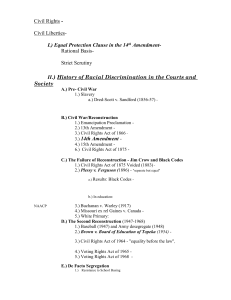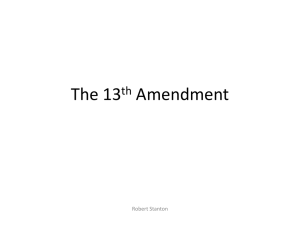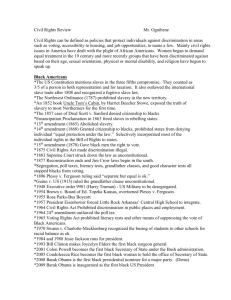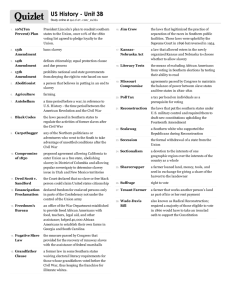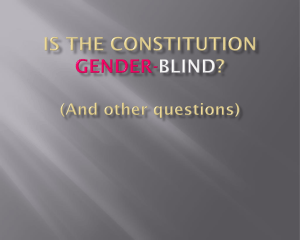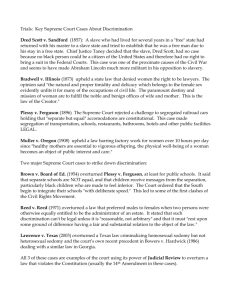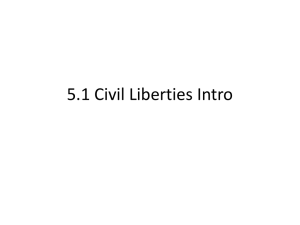CIVIL RIGHTS
advertisement
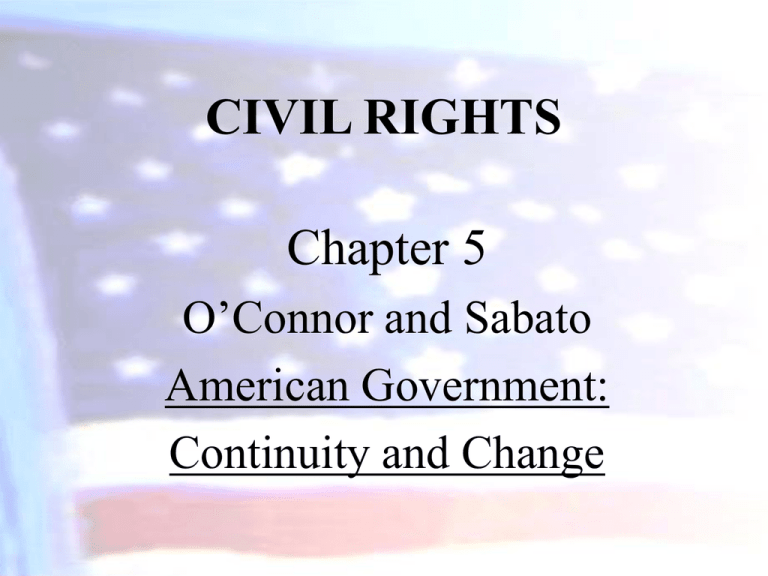
CIVIL RIGHTS Chapter 5 O’Connor and Sabato American Government: Continuity and Change CIVIL RIGHTS In this chapter we will cover… 1. Slavery, Abolition, and Winning the Right to Vote, 1800-90 2. The Push for Equality, 1890-1954 3. The Civil Rights Movement 4. Other Groups Mobilize for Rights 5. Affirmative Action 6. Continuity and Change What are Civil Rights? Civil Rights refers to the positive acts governments take to protect against arbitrary or discriminatory treatment by government or individuals. 1. Slavery, Abolition and Winning the Right to Vote (1800-1890) • A National Crisis over Slavery – 1808 Congress banned slave trade – The South was heavily dependent on the cheap slave labor – The North was becoming industrial – 1820 Missouri applied for admission as a slave state. – Admission of Missouri as a slave state would have given the slave states a majority in the Senate and was strongly oppose in the North. Missouri Compromise (1820) • Allowed the admission of Missouri as a slave state along with the admission of Maine as a free state. • Balance of power was preserved but the conflict raged on. The Abolitionist Movement • Founded by William Lloyd Garrison, the American Anti-Slavery Society (1833) reinvigorated the abolitionist movement. • Northern interest in emancipation, pushed by abolitionists, eroded relations between the north and south. • William Lloyd Garrison's Liberator was the voice of abolitionism, calling for immediate emancipation of the slaves. Heightened Tensions (1850s) • In 1852, Harriet Beecher Stowe published Uncle Tom’s Cabin. • In Scott vs. Sanford (1857) the Supreme Court ruled that slaves were not citizens of the United States. Why a Civil War? • Conflict, of course, over slavery (the Justice Taney Court left little choice) • • • • Conflict over nullification North’s increasing strength in Congress Southern agriculture v. Northern industry Southern conservative culture v. Northern progressive ideas Emancipation Proclamation (1863) • Abraham Lincoln on January 1, 1863, during the American Civil War, declared all "slaves within any State, or designated part of a State ... then ... in rebellion, ... shall be then, thenceforward, and forever free." The Civil War Amendments • 13th Amendment – banned all forms of slavery and involuntary servitude • 14th Amendment -- guarantees equal protection of the laws and due process to all citizens • 15th Amendment -- specifically gives blacks the right to vote Women’s rights werethenot addressed Shortly after ratification Southern states indevised theseways Amendments! around these amendments by passing laws that restricted opportunities for Black Americans. Black Codes • Southern states passed laws (Black Codes) that prohibited Black Americans from – Voting – Sitting on juries – Or even appearing in public places Jim Crow Laws • During the years of Jim Crow, state laws mandated racial separation in – – – – – – – – schools parks playgrounds restaurants hotels public transportation theatres restrooms and so on. • These laws remained in effect throughout the 1960’s Civil Rights Movement. Intent of the 15th Amendment • To avoid the intent of the 15th Amendment Southerners moved to exclude the African American voter with – Poll taxes – Literacy Test – Whites only primaries – Grandfather clause Sample Questions from a Literacy Test State of Louisiana One wrong answer denotes failure of the test. (10 min) 1. Draw a line around the number or letter of this sentence. 2. 3. 4. 5. 6. 7. 8. Draw a line under the last word in this line. Cross out the longest word in this line. Draw a line around the shortest word in this line. Circle the first, first letter of the alphabet in this line. In the space below draw three circles, one inside the other. Above the letter X make a small cross. Draw a line through the letter below that comes earliest in the alphabet. ZVSEDGMKYTPHC Draw a line through the letter below that comes last in the alphabet. ZVSEDGMKYTPHC In the space below write the word noise backwards and place a dot over what would be its second letter should it have been written forward. Give your age in days. 9. 10. 11. 2. The Push for Equality 1890-1954 • The Progressive Era (1889-1920) saw many reforms in – Child labor laws – Monopolies – And prejudice. • However, in what many call the Supreme Court’s darkest hour, the Court legitimized the principle of "separate but equal" in its ruling Plessy v. Ferguson. Plessy v. Ferguson (1896) • Homer Adolph Plessy (7/8ths white 1/8th black) boarded a train in New Orleans and sat in the “whites only” car. • Plessy was arrested when he refused to sit in the “colored car.” • Plessy sued arguing that the 14th Amendment made racial segregation illegal. Separate But Equal Doctrine • The Supreme Court ruled in Plessy that the Louisiana law was constitutional and that separate but equal facilities for blacks did not violate the Equal Protection Clause. • The high court Plessy ruling led to a profusion of Jim Crow laws. • By 1914 every Southern state had passed laws that created two separate societies--one black, the other white. The Lone Dissenter in Plessy • Justice John Harlan, showed foresight when he wrote: • “Our Constitution is color-blind, and neither knows nor tolerates classes among citizens. In respect of civil rights, all citizens are equal before the law. In my opinion, the judgment this day rendered will, in time, prove to be quite as pernicious as the decision made by this tribunal in the Dred Scott case.” Organizations Form to Push for Equality • Formation of NAACP (1909) • Key Women’s Groups –NAWSA –Temperance League –National Consumers’ League Women are allowed to Vote! • Coalitions of women’s groups th secured the ratification of the 19 Amendment (1920) guaranteeing all women the right to vote. Litigating for Equality • The NAACP set up a legal defense fund (LDF) to pursue equality in the nation’s courts. • The Court ruled in Sweatt vs. Painter that it would be impossible for the State of Texas to provide an equal legal education in a separate setting. Litigating for Equality • In 1950, the Court ruled in favor of Mr. Sweatt and forced the University of Texas Law School to admit him. • In Sweatt vs. Painter the Supreme Court struck down the system of "separate but equal" in graduate school education and paved the way for the landmark decision of Brown v. Board of Education in 1954. Brown vs. Board of Education • Linda Carol Brown, was not allowed to attend a school four blocks from her house because it was for white students. Instead, she had to walk twentyone blocks to the nearest allblack school. Brown vs. Board of Education • The NAACP argued that the intellectual, psychological, and financial damage that befell Black Americans precluded any finding of equality under the separate but equal policy. Brown vs. Board of Education 64 years after the Plessy decision the Court the struck down the "separate but equal" doctrine in the landmark Brown vs. Board of Education of Topeka, Kansas (1954) decision. “With All Deliberate Speed” • The Court struggled over a remedy. • A year later, in Brown II the Court ruled that segregated systems must be dismantled “with all deliberate speed.” • Central High and Governor Orval Faubus illustrate the long and costly battle to end segregation. 3. The Civil Rights Movement • The Brown vs. Board decision sparked the development of the modern civil rights movement. The Triumph of Non-Violent Protest • In 1955, Rosa Parks challenges segregation in public transportation • A new young preacher in Montgomery was selected to lead the challenge against the segregated bus system. • After a year the boycott succeeded. Non-Violent Protests • Dr. Martin Luther King Jr. advocated a nonviolent approach to forcing social change. King modeled his philosophy on that of Gandhi, who successfully employed the nonviolent approach in a revolt against the British in India shortly after World War II. Southern Christian Leadership Council (SCLC) • Dr. King founded the SCLC in 1957. This group used non-violent means such as • Freedom-rides, sit-ins and boycotts were used to open segregated lunch counters, waiting rooms, public swimming pools, and other public places. • Often local police attacked the peaceful protestors or chose not to defend them from attacking segregationists. The March on Washington • In August 1963, more than 250,000 people marched peacefully on Washington to show support for President Kennedy’s request that Congress ban discrimination in public accommodation. • King delivered his “I Have a Dream” speech. The Civil Rights Act of 1964 • Outlawed arbitrary discrimination in voter registration • Barred discrimination in public accommodation • Authorized the US Justice Department to initiate lawsuits to desegregate schools and public facilities • Allowed the federal government to withhold funds from discriminatory state and local programs • Prohibited discrimination on the basis of race, color, religion, national origin or sex • Created the Equal Employment Opportunity Commission (EEOC) to monitor and enforce bans on employment discrimination The Impact of the Civil Rights Act of 1964 • Southerners argued that the Act violated the Constitution and was an unwarranted use of federal power. • The Court ruled that state imposed (de jure) segregation must be eliminated at once. • However, a full decade after Brown, less than 1% of African American children in the South attended integrated schools. • Over time, these rulings and laws opened up numerous occupations to minorities but especially to women. The Women’s Rights Movement • In 1961, President Kennedy created a Commission on the Status of Women. The Commission’s report titled “American Women” detailed pervasive discrimination against women. • The Feminine Mystique (1963) added to the dawning recognition that something was wrong. • Although the Civil Rights Act of 1964 included a prohibition against gender discrimination, the EEOC failed to enforce the law. Women’s Rights Movement • In 1966, the National Organization for Women (NOW) was formed to address the many problems faced by women. Equal Rights Amendment • Equal Rights Amendment battle –Roe v. Wade backlash –draft eligibility –ratification deadline –Court’s expansive view of 14th Amendment 4. Other Groups Mobilize for Rights • Denial of civil rights has led many other disadvantaged groups to mobilize to achieve greater civil rights. • Their efforts to achieve those rights have many parallels to the efforts made by African Americans and women. Native Americans • Native American are the first “true” Americans, and their status under U.S. law is unique. • “Indian tribes” under the Constitution are considered distinct governments. Hispanic Americans • Hispanic Americans borrowed tactics fro the African American civil rights movement including sit ins, boycotts, marches, and activities that draw publicity. • The Hispanic community also relied heavily on litigation strategies. • MALDEF and others have been successful in expanding rights and opportunities for Hispanics. "One of the heroic figures of our time." Senator Robert F. Kennedy Cesar Estrada Chavez founded and led the first successful farm workers' union in U.S. history. Gays and Lesbians • Lambda Legal Defense and Education Fund • Bowers v. Hardwick (1986) • “Don’t ask, don’t tell” • Romer v. Evans (1996) • Boy Scouts of America et al. v. Dale (2000) Percentage of adults ages 18 to 24 who have completed high school by race and Hispanic origin, 1980-97 5. Affirmative Action • Is a policy designed to redress prior discrimination. • Bakke v. Regents of the University of California (1978) • Hopwood v. Texas (1996) • Prop 209 (1996) Hopwood v.Texas (1996) • Applications to the University of Texas Law School from black students dropped 42 percent in one year, and only 4 black and 26 Hispanic students are among the 468 students in the school's freshman class. • Applications to the school's undergraduate program fell 26 percent for blacks and 23 percent for Hispanics. 6. Continuity and Change • It took over 100 years from the first shot of the Civil War until the Civil Rights Act of 1964 and the Voting Rights of 1965 for African Americans to begin to fully exercise their rights. • Women only achieved the right to vote in 1920. • Still today we do not have a consensus in America about race and gender relations. • Many argue that racism and sexism are alive and well in America.
